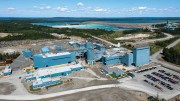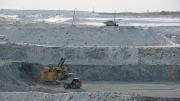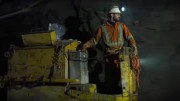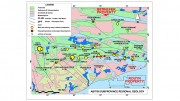The O’Brien gold mine in the Abitibi region of northwestern Quebec was the richest mine by grade along the Larder Lake-Cadillac Fault between 1926 and 1957, when miners intermittently made an estimated 587,121 oz. gold at the the underground operation from 1.1 million tonnes grading 15.25 grams gold per tonne.
The past producer and surrounding 6.4 sq. km property package is now owned by Radisson Mining Resources (TSXV: RDS), a junior exploration company that acquired the asset from Breakwater Resources in two stages that lasted from 1994 to 1999, when Breakwater quit the gold business to focus on zinc.
Now the O’Brien project — halfway between the province’s mining towns of Rouyn-Noranda and Val-d’Or, and 500 metres north of the Trans-Canada Highway 117 — is surrounded by three active gold mines. Agnico Eagle Mines’ (TSX: AEM; NYSE: AEM) Lapa and LaRonde mines are 8 km and 13 km from the project, while Iamgold’s (TSX: IMG; NYSE: IAG) Westwood mine lies 16 km away.
And like Lapa, LaRonde and Westwood today, O’Brien was mined to more than 1,000 metres deep. Previous operators extracted ore from O’Brien to 1,100 metres deep. LaRonde is 3,500 metres below surface, while Westwood is 2,000 metres below surface and Lapa is 1,500 metres below surface.
Radisson has drilled two deep holes into its 36E zone, 500 metres along strike east of the old O’Brien mine, and in the same lithology. The first returned an intercept of 17 grams gold per tonne over 1 metre at 1,150 metres deep, and the second assayed 13.6 grams over half a metre at 1,100 metres deep.
The company has also produced a resource estimate for the 36E zone and the adjacent Kegawama zone, farther east, which incorporates holes drilled between surface and 700 metres deep.
Indicated resources stand at 570,800 tonnes grading 6.53 grams gold per tonne for 119,819 oz. gold, and inferred resources add 918,300 tonnes grading 6.38 grams gold for 188,466 oz. gold. The resource calculation uses a 3.5-gram-gold cut-off grade.
Radisson plans to update the resource numbers in the fourth quarter of 2017 based on 25,000 metres of drilling. It completed a 5,700-metre drill program in August and announced another 10,000-metre drill program in October.
The company is confident that it can add value to the project with more exploration at shallow depths in areas that have not been explored, as well as at depth, and has defined more than 90 drill targets to increase the resource.
“We believe 36E and Kewagama are two lenses that could compare to the former O’Brien mine because it’s the same lithology, it’s the same mineralization and we have hit visible gold in one out of every three holes drilled in 2016,” Hubert Parent-Bouchard, the company’s vice-president of corporate development, says in an interview.
“We have lateral continuity … and we feel that the O’Brien mine could go to a deeper level as well, based on what we see in the mining camp. We have the chance to have a discovery laterally and intersections at depth suggest there is vertical continuity.”
The resource for the 36E and Kewagama zones come from the Piché Group of volcanic rocks on the property, which separate the Pontiac Group meta-sedimentary rocks south from the Cadillac Group meta-sedimentary rocks to the north.
“It’s obvious there is a mine within the Piché volcanic group,” Parent-Bouchard says. “But is there something bigger in the Pontiac Group to the south? We have hit interesting mineralization in the Pontiac, with intercepts like 23.79 grams gold over 0.5 metre, and a historic drill hole returned 15.90 grams gold over 6.7 metres.”
On Nov. 2, the company reported more drill results from the Pontiac Group. One drill hole returned 3.82 grams gold over 1.5 metres deep of 315 metres. On Aug. 25 another intercept from the Pontiac Group was released, measuring 5.45 grams gold over 1 metre at 303 metres deep.
In addition to the drill program, Radisson plans to log 15,000 metres of historic drill core.
“Historically there were 60,000 metres of drilling done on the property — 15,000 metres crossed the Pontiac Group and are still at the core shack, and have never been logged,” he says. “We are logging this drill core. Samples have been sent to the laboratory for assays and results are still pending.
“A geologist is working full time logging the historic core to figure out what is of interest in the Pontiac Group on the O’Brien project,” he continues. “In the meantime, an Orevision induced-polarization geophysics program added exploration targets in the Pontiac Group, and results should be available by year-end.
“We are building a unique database to build a geological interpretation of the project towards the new resource estimate,” he says, adding that the company is digitizing 90 years of work representing 60 km of drilling.
In 2014, Radisson also completed metallurgical studies on ore taken from the 36E zone, which returned an average head grade of 11.13 grams gold.
“Metallurgical testing was done on a 61-kilogram sample that graded 7.26 grams gold per tonne,” he says. “Three tests were done to estimate recovery and all three returned values above 9 grams per tonne. The average was 11.13 grams per tonne. An average 59.2% of the gold was recovered via gravity concentration, supporting our view that there is a strong nugget effect on 36E, just like in the old O’Brien mine. The rest could be recovered through cyanidation or flotation.”
Parent-Bouchard notes that drilling costs of $95 per metre make it “one of the lowest-cost explorers in the industry.” He says the project is located in one of the most renowned mining camps in Canada, 1 km from a provincial road, and that most of the contractors are based there. This allows effective allocation of capital.
“If you look at the O’Brien project, it’s halfway between Rouyn-Noranda and Val-d’Or, two mining towns. It’s easily accessible via road. People can go home at night after their shift so it’s good for employees, and mobilization is not an issue.”
The company has grown from a $3-million market capitalization in 2013 to $9 million in 2014, $15 million in 2015 and $16 million this year.
Radisson has 106.6 million shares outstanding and at press time traded at 16.5¢ per share. Over the last year the company has traded between 9¢ and 18¢ per share.
Management and insiders own 14% of the company’s shares, with US Global funds making up 7%, the Caisse de Dépôt, 5%; and other institutions, 5%. Private investors hold 28% of the company’s shares, and the rest is held by retail investors.
The company has $2.75 million in its treasury.





Be the first to comment on "Radisson Mining advances O’Brien gold project in Quebec’s Abitibi "